
Business — Looking for Funding to Upgrade Your Operation
When Revolution Farms opened its 1-acre greenhouse facility in 2018 in Caledonia, Michigan, the company considered LED grow lights to be essential for year-round production of its hydroponic lettuce crops. The company grows eight different lettuce varieties that are sold to Meijer and SpartanNash grocery stores, as well as independent grocers and food service distributors Sysco, Gordon Food Service, and Van Eerden Foodservice.
When Revolution Farms expanded its facilities with two additional acres of greenhouses in 2020, LED lights were a key component of the expansion.
“In 2020 we not only equipped the new greenhouses with LEDs, but we also phased out the LED lights that had been installed in our first greenhouse in 2018,” says Tim Vogelzang, chief financial officer at Revolution Farms. “The LEDs we installed in 2020 were much better grow lights in regard to intensity, efficiency and the full light spectrum than the lights installed in 2018.
“The first greenhouse with the original LEDs felt like an old facility even though it was only a couple years old due to how much the LED technology had changed in that short time. Another reason for replacing the old LEDs was we were able to receive a rebate on all the new lights for both the old and new greenhouses.”
The grow lights are also used during the summer when the greenhouses can heat up from the natural light.
“During the middle of August when the greenhouses heat up, lettuce doesn’t do well under 80 to 90º F temperatures and that can affect our yields,” Vogelzang says. “It may sound counter intuitive, but sometimes we close the shade curtains to keep the sunlight out during the heat of the day. If the light sensors indicate that the shade cloth has been closed too long, the lights may come on and provide the plants with additional light.
“It’s more efficient to operate the lights than the HVAC system to cool down the greenhouses. The greenhouses can’t be cooled down quickly. It’s better to maintain the proper temperature and then operate the lights if necessary.”

IT PAYS TO DO YOUR HOMEWORK
Before making a decision on which LED lights to install, Revolution Farms contacted three different lighting manufacturers.
“We worked with Consumers Energy, which is our local energy provider, to source the new lights,” Vogelzang says. “We purchased the lights through Fluence. Fluence representatives were instrumental in determining what lights would best work for us and would qualify for the rebate program with our electricity provider.”
The rebate process for the lights was timeconsuming, but well worth the effort.
“We had a good experience working with Fluence and our utility company on the rebate program,” Vogelzang says. “Consumers Energy was very intune with what we were doing. It has specialists that work with commercial growers. Already having a production facility up and operating was helpful in processing the administrative paperwork that had to be completed for the rebate program.”
In addition to the rebate for the LEDs, Revolution Farms also received a $15,000 grant from Michigan Department of Environment, Great Lakes and Energy for the grow lights and the energy curtains it installed in its new greenhouses.
Other rebates that Revolution Farms received for equipment it installed included:
• A daylight sensor control system that automatically operates the grow lights based on the amount of sunlight.
• Gas water heaters from DTE Energy for cleaning equipment.
• Variable speed-drive air compressors for automating machinery.
The total amount for rebates added up to $633,200.
Vogelzang says growers need to plan ahead when doing a retrofit or new construction to ensure they qualify for potential grants and rebates.
“Talk with the vendors you are interested in working with to determine if any of the construction you are doing qualifies for any of these programs,” he says. “Check in with the local economic development council, utility companies and other state agencies. There are usually officials who can help in acquiring grants and rebates. Make sure the equipment that is being considered for installation qualifies for the grants and rebates.”
TRANSITIONING TO HIGH-VALUE CROPS
Wheatfield Gardens in North Tonawanda, New York, began operating in 2016 when it purchased an existing 12 ½-acre glass greenhouse. “For six years we have been transitioning the facility to grow high-value crops,” says Paal Elfstrum, founder and CEO. “In 2018 we began growing cannabinoid hemp, leafy greens and herbs. Now that New York state has legalized adult-use cannabis, we have obtained a license to produce that crop.
“We received our license to produce adult-use cannabis in April 2022 and we immediately started growing the crop. We are currently operating under a provisional license for adult-use cannabis. Based on permanent regulations issued by the state, [it] will determine the canopy size that we can operate. We have been granted 100,000 square feet, but we’d like to increase production space to 200,000 square feet. The state is trying to control the market so that there is no overproduction. They’re limiting the canopy size for any one licensee.”

COMMITTED TO BEING MORE ENERGY EFFICIENT, SUSTAINABLE
Wheatfield Gardens has worked with New York State Energy Research and Development Authority (NYSERDA) on several improvement projects to reduce
energy consumption.
“Our cogeneration project which occurred in 2018-2019 was the first one that we worked with NYSERDA on,” Elfstrum says. “It took a year to put in the cogeneration system. NYSERDA has a long-standing program that incentivizes the efficient installation of cogeneration. The incentive is contingent upon running the cogeneration plant at an overall thermal efficiency of 65%. This means electricity is being produced with an appropriate amount of heat being recovered from the electrical production, including engine friction and exhaust heat. We capture all sources of thermal energy and are able to exceed that 65% threshold allowing us to achieve the financial incentives through the system’s performance.”
Wheatfield Gardens’ most recent project with NYSERDA used the GLASE Greenhouse Database & Benchmark Tool. The company worked with NYSERDA to conduct a full energy audit to compare its energy usage with other growers in the state.
“We also want to work with NYSERDA on battery storage for our cogeneration system, so that we can operate a true microgrid,” Elfstrum says. “This would enable us to run the engine, and, if there aren’t any loads within the building, depending on the time of year, the batteries could store the energy. This especially makes sense based on the rising cost of natural gas. We can store the electricity in stationary batteries and then deploy it during peak hours. This would reduce having to pay peak prices for electricity.”
Wheatfield Gardens worked with its local utility company, National Grid, on many of its financial incentives and rebates, including LED grow lights, environmental controls, and variable frequency drives.
“Installing variable frequency drives (VFDs) for our exhaust fans has definitely saved electricity over time, but they are more expensive,” Elfstrum says. “National Grid is helping us to calculate the savings and then giving us an immediate rebate to buy down the capital expense using the calculated energy savings to help us afford the VFDs. We don’t need these, but it’s the right thing to do. That is the attitude that we have taken toward these types of improvements in order to be more sustainable.”
Wheatfield Gardens has also worked with its natural gas provider, Natural Fuel Gas, to receive rebate incentives for installing more efficient boiler controls.
“The more sophisticated boiler control system, called an Autoflame, enables our boilers to run more efficiently by heating the water incrementally based on the outside temperature,” Elfstrum says. “The utility company calculated how much gas would be saved over a given period of time and then paid us a one-time rebate based on the gas savings. The rebate was for $5,000, which was about 25% of the total cost.”
REPLACING LEDS WITH LEDS
Wheatfield Gardens first installed LED grow lights in 2018 and has since replaced some of the lights from the initial installation with more efficient fixtures.
“Prior to purchasing this facility in 2016, the greenhouses never had a grow light,” Elfstrum says. “Our commitment to efficiency and sustainability has been from Day 1 so we have embraced LEDs from the beginning.
“We have upgraded some of the LEDs that we installed in 2018 that weren’t particularly efficient. We worked with National Grid representatives explaining why we were buying more efficient lights. The utility company was able to calculate based on the new LEDs efficiency rating how much electricity we would save. We qualified for another rebate even though we were replacing LEDs with LEDs.”
Wheatfield Gardens is planning to install more LEDs when it expands its production of adult-use cannabis. The company plans to apply for rebates again for these additional lights.
WORKING WITH UTILITY COMPANIES, STATE AGENCIES
Elfstrum advises growers not to take an adversarial attitude when dealing with their utility companies.
“Having open communication with the utility companies and soliciting them to say we have good ideas that could save money is the better way to go,” he says. “Our bottom line is dictated by the amount of energy we use. It is one of our inputs, so finding ways to use fewer inputs with the same results is the heart of farming philosophy. Concrete actions and communication seem to be working for us where we are trying to find ways to use less and take advantage of any programs that might be available from the utility companies to reach our goals.
“Growers should reach out to the utility companies to determine what incentive programs are available. Also, there may be an opportunity for custom grant or rebate programs that take into account some of the equipment that is unique to controlled environment agriculture. A utility company may be able to establish an incentive equation that takes into account the amount of electricity or natural gas that will be saved by buying more energy-efficient equipment.”
Elfstrum says he found out about the programs offered by NYSERDA by visiting the agency’s website and looking at the industry events it sponsors.
“Being involved with industry organizations like GLASE, I have learned a lot from working with academics and the Cornell Cooperative Extension,” he says. “Also, the local USDA office representatives are a wealth of knowledge. You have to know about the programs available in order to take advantage of them.”
For an enhanced reading experience, view this article in our digital edition by clicking here.









 Video Library
Video Library 


















